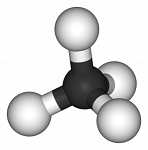Cannizzaro Reaction
- Page ID
- 66862
The Cannizzaro reaction, named after its discoverer Stanislao Cannizzaro, is a chemical reaction that involves the base-induced disproportionation of an aldehyde lacking a hydrogen atom in the alpha position

By Krishnavedala (Own work) [Public domain], via Wikimedia Commons
Cannizzaro first accomplished this transformation in 1853, when he obtained benzyl alcohol and potassium benzoate from the treatment of benzaldehyde with potash (potassium carbonate). More typically, the reaction would be conducted with sodium or potassium hydroxide:
2 C6H5CHO + KOH → C6H5CH2OH + C6H5COOK
The oxidation product is a salt of a carboxylic acid and the reduction product is an alcohol.
Mechanism
The reaction involves a nucleophilic acyl substitution on an aldehyde, with the leaving group concurrently attacking another aldehyde in the second step. First, hydroxide attacks a carbonyl. The resulting tetrahedral intermediate then collapses, re-forming the carbonyl and transferring hydride to attack another carbonyl. In the final step of the reaction, the acid and alkoxide ions formed exchange a proton. In the presence of a very high concentration of base, the aldehyde first forms a doubly charged anion from which a hydride ion is transferred to the second molecule of aldehyde to form carboxylate and alkoxide ions. Subsequently, the alkoxide ion acquires a proton from the solvent.

By Krishnavedala (Own work) [Public domain], via Wikimedia Commons
Overall, the reaction follows third-order kinetics. It is second order in aldehyde and first order in base:
\[rate = k[RCHO]^2[OH^−]\]
At very high base a second path (k') becomes important that is second order in base:
\[rate = k[RCHO]^2[OH^−] + k'[RCHO]^2[OH^−]^2\]
The k' pathway implicates a reaction between the doubly charged anion (RCHO22−) and the aldehyde. The direct transfer of hydride ion is evident from the observation that the recovered alcohol does not contain any deuterium attached to the α-carbon when the reaction is performed in the presence of D2O.
Scope
Due to the strongly alkaline reaction conditions, aldehydes that have alpha hydrogen atom(s) instead undergo deprotonation there, leading to enolates and possible aldol reactions. Under ideal conditions the reaction produces only 50% of the alcohol and the carboxylic acid (it takes two aldehydes to produce one acid and one alcohol). To avoid the low yields, it is more common to conduct the crossed Cannizzaro reaction, in which a sacrificial aldehyde is used in combination with a more valuable chemical. In this variation, the reductant is formaldehyde, which is oxidized to sodium formate and the other aldehyde chemical is reduced to the alcohol. In this scenario, each of the two separate aldehydes can be converted completely to its corresponding product rather than losing 50% of a single reactant to each of two different products. Thus, the yield of the valuable chemical is high, although the atom economy is still low.
A solvent-free reaction has been reported involving grinding liquid 2-chlorobenzaldehyde with potassium hydroxide in a mortar and pestle:

V8rik at English Wikipedia [CC BY-SA 3.0 (http://creativecommons.org/licenses/by-sa/3.0) or GFDL (http://www.gnu.org/copyleft/fdl.html)], via Wikimedia Commons
Certain ketones can undergo a Cannizzaro-type reaction, transferring one of their two carbon groups rather than the hydride that would be present on an aldehyde.
Variations
In the Tishchenko reaction, the base used is an alkoxide rather than hydroxide, and the product is an ester rather than the separate alcohol and carboxylate groups. After the nucleophilic base attacks an aldehyde, the resulting new oxygen anion attacks another aldehyde to give a hemiacetal linkage between two of the formerly aldehyde-containing reactants rather than undergoing tetrahedral collapse. Eventually tetrahedral collapse does occur, giving the stable ester product.
By Calvero. (Selfmade with ChemDraw.) [Public domain], via Wikimedia Commons
See also
- Meerwein–Ponndorf–Verley reduction
- Oppenauer oxidation
References
- Cannizzaro, S. (1853). "Ueber den der Benzoësäure entsprechenden Alkohol" [On the alcohol corresponding to benzoic acid]. Liebigs Annalen der Chemie und Pharmacie. 88: 129–130. Doi:10.1002/jlac.18530880114.
- List, K.; Limpricht, H. (1854). "Ueber das sogenannte Benzoëoxyd und einige andere gepaarte Verbindungen" [On so-called benzoic oxide and some other paired compounds]. Liebigs Annalen der Chemie und Pharmacie. 90 (2): 190–210. doi:10.1002/jlac.18540900211.
- Geissman, T. A. "The Cannizzaro Reaction" Org. React. 1944, 2, 94. doi:10.1002/0471264180.or002.03(Review)
- Smith, Michael B.; March, Jerry (2007), Advanced Organic Chemistry: Reactions, Mechanisms, and Structure (6th ed.), New York: Wiley-Interscience, ISBN 0-471-72091-7
- W. C. Wilson (1941). "2-Furancarboxylic Acid and 2-Furylcarbinol". Org. Synth.; Coll. Vol., 1, p. 276
- A Facile Solvent-Free Cannizzaro Reaction Phonchaiya, Sonthi; Panijpan, Bhinyo Rajviroongit, Shuleewan; Wright, Tony; Blanchfield, Joanne T. "A Facile Solvent-Free Cannizzaro Reaction" J. Chem. Educ. 2009, volume 86, page 85. doi:10.1021/ed086p85
- Jiang, Xin-Dong; Matsukawa, Shiro; Kakuda, Ken-ichiro; Fukuzaki, Yuta; Zhao, Wei-Li; Li, Lin-Song; Shen, Huai-Bin; Kojim, Satoshi; Yamamoto, Yohsuke (2010). "Efficient synthesis of tetradecafluoro-4-phenylheptan-4-ol by a Cannizzaro-type reaction and application of the alcohol as a bulky Martin ligand variant for a new anti-apicophilic phosphorane". Dalton Trans. 39: 9823–9829. doi:10.1039/C0DT00539H
Contributors
Wikipedia (CC-BY-SA-3.0)



